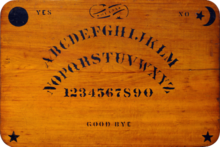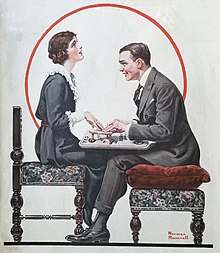
Back ويجا Arabic Ouija Catalan Ouija Czech Ouija Danish Ouija German Πίνακας Ouija Greek Literumita tabulo Esperanto Güija Spanish Ouija Basque ویجا Persian


| Part of a series on |
| Spiritualism |
|---|
|
|
The Ouija (/ˈwiːdʒə/ ⓘ WEE-jə, /-dʒi/ -jee), also known as a Ouija board, weegee board, spirit board, talking board, or witch board, is a flat board marked with the letters of the Latin alphabet, the numbers 0–9, the words "yes", "no", and occasionally "hello" and "goodbye", along with various symbols and graphics. It uses a planchette (a small heart-shaped piece of wood or plastic) as a movable indicator to spell out messages during a séance. Participants place their fingers on the planchette, and it is moved about the board to spell out words. The name "Ouija" is a trademark of Hasbro[1] (inherited from Parker Brothers), but is often used generically to refer to any talking board.
Spiritualists in the United States believed that the dead were able to contact the living, and reportedly used a talking board very similar to the modern Ouija board at their camps in Ohio during 1886 with the intent of enabling faster communication with spirits.[2] Following its commercial patent by businessman Elijah Bond being passed on 10 February 1891,[3] the Ouija board was regarded as an innocent parlor game unrelated to the occult until American spiritualist Pearl Curran popularized its use as a divining tool during World War I.[4]
Paranormal and supernatural beliefs associated with Ouija have been criticized by the scientific community and are characterized as pseudoscience. The action of the board can be most easily explained by unconscious movements of those controlling the pointer, a psychophysiological phenomenon known as the ideomotor effect.[2][5][6][7][8]
Mainstream Christian denominations, including Catholicism, have warned against the use of Ouija boards, considering their use in Satanic practices, while other religious groups hold that they can lead to demonic possession.[9][10] Occultists, on the other hand, are divided on the issue, with some claiming it can be a tool for positive transformation, while others reiterate the warnings of many Christians and caution "inexperienced users" against it.[9]
- ^ U.S. Trademark 71,546,217
- ^ a b Cite error: The named reference
Rodriguez McRobbie 2013was invoked but never defined (see the help page). - ^ "The Bel Air native who patented the Ouija Board". Dying to tell their stories. 17 January 2018. Archived from the original on 4 November 2023. Retrieved 23 July 2024.
- ^ Brunvand, Jan Harold (2006) [1996]. "Ouija". American folklore: An encyclopedia. Taylor & Francis. p. 534. ISBN 978-1-135-57877-0.
- ^ Heap, Michael (14 November 2002). "Ideomotor Effect (the Ouija Board Effect)". In Shermer, Michael (ed.). The Skeptic Encyclopedia of Pseudoscience. ABC-CLIO. pp. 127–129. ISBN 1-57607-654-7.
- ^ Adams, Cecil; Ed Zotti (3 July 2000). "How does a Ouija board work?". The Straight Dope. Retrieved 6 July 2010.
- ^ Carroll, Robert T. (31 October 2009). "Ouija board". Skeptic's Dictionary. Retrieved 6 July 2010.
- ^ French, Chris (27 April 2013). "The unseen force that drives Ouija boards and fake bomb detectors". The Guardian. Archived from the original on 24 December 2019. Retrieved 16 October 2023.
- ^ a b Ellis, Bill (2000). Raising the Devil: Satanism, New Religions, and the Media. University Press of Kentucky. p. 65. ISBN 978-0-8131-2682-1. Retrieved 16 October 2023.
Practically since its invention a century ago, mainstream Christian religions, including Catholicism, have warned against using Ouija boards, claiming that they are a means of dabbling with Satanism (Hunt 1985:93–95). Occultists are divided on the Ouija board's value. Jane Roberts (1966) and Gina Covina (1979) express confidence that it is a device for positive transformation and they provide detailed instructions on how to use it to contact spirits and map the other world. But some occultists have echoed Christian warnings, cautioning inexperienced persons away from it.
- ^ Carlisle, Rodney P. (2009). Encyclopedia of Play in Today's Society. Sage Publications. p. 434. ISBN 978-1412966702.
In particular, Ouija boards and automatic writing are kin in that they can be practiced and explained both by parties who see them as instruments of psychological discovery; and both are abhorred by some religious groups as gateways to demonic possession, as the abandonment of will and invitation to external forces represents for them an act much like presenting an open wound to a germ-filled environment.